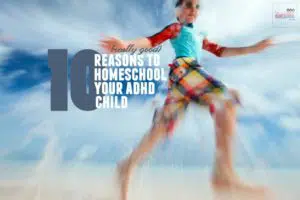5 Tips for Homeschooling Active Kids
5 Tips for Homeschooling Active Kids
Does your child have an ADHD diagnosis? Or maybe you just have a child who happens to be super active? (After all, God created kids to be active and energetic! I just wish we parents had as much energy as our kids tend to have!)
If your child has a diagnosis or just has a lot of energy and focus is a struggle, homeschooling might be the right fit for your family. This is because, when schooling at home, parents have the ability to tailor a child’s learning to that child’s individual educational needs.
What does that mean?
How to Tailor Your Child’s Homeschool to Your Child’s Needs
Put simply, you choose your child’s curriculum, the time of day you do schoolwork, and how much time you spend on each subject. You get to choose how and when grades are kept (within your state’s homeschool guidelines, of course). In other words, you get to adjust your homeschool to your child’s needs.
Here are a few examples.
If you have a hands-on learner, you might choose a math curriculum that uses manipulatives to reinforce lessons taught.
Or if you have a visual learner, you might opt for a video curriculum for certain subjects. This allows your child to pause, rewind, and rewatch as often as necessary.
If your child has a short attention span, frequent breaks may be needed to keep that child focused and on track.
Whatever your child needs, homeschooling allows you to tweak your curriculum and schedule to make it work.
That said, it isn’t always easy to homeschool a child with ADHD.
If he or she struggled at school, chances are the struggle may continue at home too – at least until you find your groove.
Here are 5 key things to remember when homeschooling a child who has lots of energy:
5 Key Things to Remember When Homeschooling a Child with ADHD
1. Remember that every child is different.
I’m starting out with this one because it’s a biggie.
It’s so important to remember that EVERY child is different, whether that child has a diagnosis or not.
Every child has both struggles and strengths. Every human has both struggles and strengths.
It’s critical that you keep this at the forefront of your mind and commit to patience when learning what works for your child (and what doesn’t).
Don’t fall into the comparison trap. Nothing good will come of it.
Instead, celebrate strengths and give grace when it comes to struggles.
That is the key to a happy homeschooling relationship.
2. Get to know your child’s learning style.
This goes hand in hand with understanding that every child is different.
It means what works for siblings may not work for that particular child, and vice versa.
What worked in the classroom may not work at home.
Here’s a simple quiz to help you identify your child’s learning style.
Once you know what style of teaching suits your child best, you can start exploring curriculum options.
Don’t get bogged down in all the choices. Research, but set a time limit and commit to making a decision.
The best way to learn what works and doesn’t work is to jump in and get started.
Pro Tip – Nothing is set in stone. If something doesn’t work, tweak it. Curriculum is not one-size-fits-all. If making adjustments isn’t enough, don’t be afraid to try something else.
3. Take frequent breaks.
No matter your child’s learning style or the curriculum you end up choosing, kids with ADHD often need frequent breaks.
Focus can be a challenge, and studying in short spurts is helpful. It gives the brain a chance to reset and come back ready for another round.
This can be as simple as setting a timer for a five-minute break between each subject. Or stopping to take a short walk mid-morning before finishing the day’s lessons. Or breaking up the day into segments and doing part of your work in the morning, stopping for lunch and outside play, and finishing up in the afternoon.
Make it work for you.
4. Movement matters.
Movement helps with concentration and focus for energetic kids and kids with ADHD.
Many times parents and teachers discourage fidgeting, but used effectively, this can be a tool to help kids stress less and retain information more easily.
This can be achieved by using tools like fidget spinners, squishy balls, or even quiet toys (like Legos or Hot Wheels) when you’re reading aloud or watching videos. I have a friend whose children love to do Shrinky Dinks and Perler beads. Do whatever your kids enjoy the most!
Exercise balls can be used as an alternative to chairs when doing written work. Or let kids stand if that’s what they prefer.
You can also use a trampoline and have kids count while jumping. Or ask math questions while playing catch.
Really, the options are endless. School at home is what you make it.
5. Prioritize rest.
For those with ADHD, sleep doesn’t always come easy. And when rest is lacking, it makes everything else seem harder.
Sleep deprivation can cause things like brain fog, irritability, and feelings of anxiousness.
Kids with ADHD already struggle with some of these, and not getting enough sleep can magnify symptoms.
Figure out how much sleep your child needs (hint – here’s a handy chart from WebMD) and use that to determine an appropriate bedtime. From there, keep to a consistent nighttime routine to help signal to your child’s brain that it’s time to wind down and go to sleep.
For those having a hard time, you can try certain natural sleep remedies to help. Some suggestions are a warm bath, diffusing lavender essential oil, no screens before bed, hot tea and honey, etc.
There are also supplements, like melatonin, known to improve sleep. Before going this route, be sure to consult with your child’s doctor and make sure it’s the right course of action.
Wrapping It Up
Bottom line, homeschooling kids with ADHD can be a wonderful way to connect and ensure an education personalized to each child’s unique strengths.
But it doesn’t come without its challenges.
The 5 tips above will help you partner with your children to give them the best learning environment possible.
Tell us….what are your top tips for homeschooling a child with ADHD?
Share in the comments below!
You May Also Like
10 Reasons to Homeschool Your ADHD Child
6 Simple Ways to Engage Unwilling Readers
Amy Thetford is a freelance writer and blogger who homeschools her tribe of tiny humans while pursuing her lifelong dream of becoming a published author. She is fueled by coffee and the desire to do ALL. THE. THINGS. She has the attention span of a squirrel, though she somehow manages to make it through each day with everyone fed and happy (well, mostly happy! Ha!) while striving to make every tomorrow better than the last.








This was our son many years ago (I started home schooling in 1986.) He was active, impulsive, and started reading before he was three. And by the way, back then the diagnosis was often Tourette’s, since no one had defined what came to be known as ADHD. You can imagine how difficult it was to hear that, but guess what– he doesn’t have Tourette’s.
I had never considered home schooling him, but I was concerned about him being academically ahead and driving his teacher and the other students crazy because he was bored. So the homeschooling journey began!
Here’s something for parents to keep in mind– doing all the above suggestions (and they are great) will be hard, but none of this will be offered to your child in a regular school setting. It’s just not possible. You are already giving him/her the best option, and you have your child’s best interest at heart. You’ll be able to cut out the busy work and frustration, and encourage your student to find what they love and are interested in. Go for it!